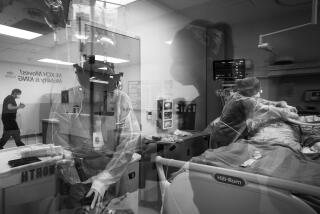Op-Ed: Could COVID-19 set off a wave of heart disease?
A teacher who was thinking of quitting the profession because of the coronavirus recently contacted me. He had read about the infection triggering a wave of heart disease and about patients who were symptomatic weeks or months after recovering from their initial coronavirus infection. He was concerned about returning to school and the prospect of carrying the virus home and infecting his family.
Certainly, ongoing health issues in recovery from COVID-19 appear common. In one Italian study, 87% of patients reported at least one symptom two months after the onset of disease. Another study from Germany reported that, among recently recovered patients, 78% had an abnormality in magnetic resonance imaging scans of their hearts. Another European study using ultrasound showed 55% of hospitalized patients had an abnormal heart finding. One study in athletes who had recovered from COVID found around 40% had an MRI imaging abnormality.
So, should we be worried about millions of patients presenting with COVID-related heart disease? It’s not so simple.
Most patients with COVID-19 don’t have symptoms, or have minimal ones. By some estimates, as many as 40% are asymptomatic and about another 40% only ever get mildly ill.
In addition, the medical profession has known for centuries that following viral illness, a small group of patients will have to endure a longer-term recovery. The fatigue syndrome that follows the flu is well recognized. The long-term fatigue that follows infectious mononucleosis is expected. These post-viral symptoms almost always resolve completely.
It is not surprising to find evidence that COVID-19 affects the body beyond the lungs. From the earliest days of the pandemic, scientists knew that the “lock” that the virus “picks” to enter cells (a receptor known as ACE2) is present on cells in areas of the body including the heart, the kidney and the gastrointestinal system. We would expect to find evidence of the immune system fighting the virus in each of these tissues, especially with exquisitely sensitive imaging technology like MRI. Most patients recover completely, even in cases of myocarditis, a severe heart inflammation where the immune cells actively invade the heart — that appears to be uncommon among COVID patients.
Finally, the widely reported heart-imaging studies in Europe represent populations more severely affected than average. In the ultrasound study, patients had to be admitted to the hospital to be included in the study and doctors had to either suspect or know of an existing heart problem before an ultrasound of the heart could be ordered. In the German MRI study, the patients were by chance more severely affected than the general population. Even the authors observed the changes were modest and of unclear significance. Earlier studies in athletes found similar rates of these MRI “abnormalities” in healthy athletes and in those who recently suffered from the common cold.
So recent headlines about a coming wave of heart disease are misleading or, at the very least, premature.
What is lost in these articles and speculation about a “new” heart disease is that regular old heart disease has not gone away. Unfortunately, some patients continue to hesitate to come to the hospital when they feel classic signs of a heart attack — chest tightness that can spread to the neck, jaw or arms, nausea, dizziness and heart palpitations. Heart doctors use a phrase: Time is muscle. The longer someone having a heart attack waits, the more heart function they might lose and the greater the danger to their life. The message is clear: Do not wait.
More than 6 million Americans have been documented as having been infected with SARS-CoV-2, which causes the disease COVID-19. Some estimates say that number should be five times as high if undocumented cases are included. With so many cases, the medical community needs to put in place systems to carefully monitor the small percentage of patients with continuing symptoms. In addition to hospital-based testing, digital applications can help doctors monitor symptoms at home.
The most reassuring news with respect to chronic COVID-19 is how much we have learned about avoiding and treating acute COVID-19. The pace of scientific advance has been dizzying — more than 50,000 papers have been written this year on COVID, which is more than five times the number that have ever been written on mononucleosis.
We now understand SARS-CoV-2 transmission dynamics and, as a result, know how to layer preventive strategies to reduce our exposure (masks, distancing, ventilation, being outdoors). We know who is most at risk (the elderly, disadvantaged and infirm). We have treatments that have been proved to save lives (the steroid dexamethasone) or reduce the impact of the illness (the antiviral drug remdesivir). Multiple promising vaccines are in late-stage trials and will likely report results in the next two to three months. All this should give us hope.
After I shared some of the context for the studies the teacher was worried about, he said he is not quitting, at least not yet.
Euan Ashley is professor of cardiovascular medicine and genetics at Stanford University and author of the forthcoming book “The Genome Odyssey: Medical Mysteries and the Incredible Quest to Solve Them.”
More to Read
A cure for the common opinion
Get thought-provoking perspectives with our weekly newsletter.
You may occasionally receive promotional content from the Los Angeles Times.










